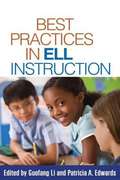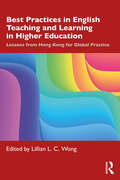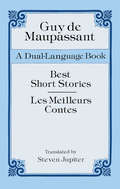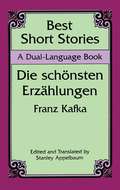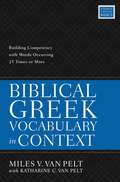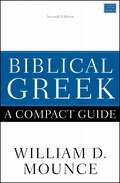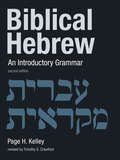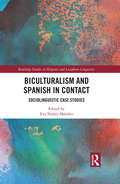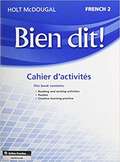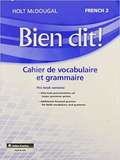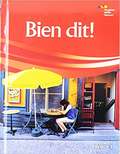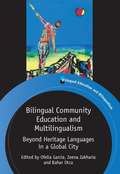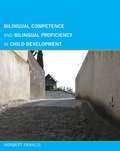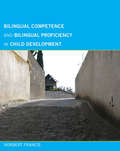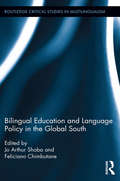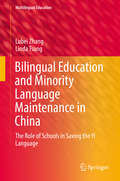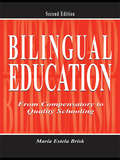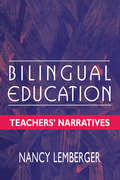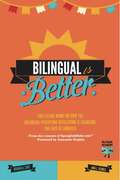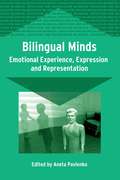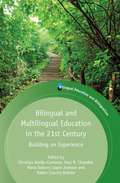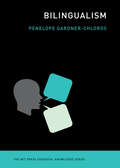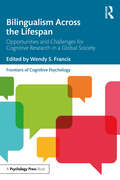- Table View
- List View
Best Practices in ELL Instruction
by Guofang Li Patricia EdwardsIn this indispensable work, prominent authorities review the latest research on all aspects of ELL instruction (K 12) and identify what works for today's students and schools. Provided are best-practice guidelines for targeting reading, writing, oral language, vocabulary, content-domain literacies, and other core skill areas; assessing culturally and linguistically diverse students; and building strong school home community partnerships. Chapters include clear-cut recommendations for teaching adolescent ELLs and those with learning disabilities. The comprehensive scope, explicit linkages from research to practice, and guidance for becoming a culturally informed, reflective practitioner make the book an ideal course text.
Best Practices in English Teaching and Learning in Higher Education: Lessons from Hong Kong for Global Practice
by Wong, Lillian L. CLillian Wong brings together evidence- informed studies which are at the forefront of higher education developments in English language teaching and learning, and shares expertise from prominent academics in Hong Kong. Written by experienced practitioners who are active in the evolving field of scholarship of teaching and learning, it provides accessible and engaging insights into best practices in new and innovative areas, such as communities of practice, scholarship, big data analytics, digital literacies, blended learning, small private online courses, dialogic use of exemplars, students as tutors and critical thinking. The book covers best practices in three interrelated key areas in university English language education, including curriculum design and pedagogy, use of technologies and the teaching and learning of English in the disciplines. Linking theory and practice, the chapters discuss the emphasis on EAP/ ESP in university English language education, how technological developments are impacting the field and the implications for further research and the teaching of English in higher education. This resourceful collection is essential reading for teachers in- service and intraining, or those working in language education at the tertiary level where English is being used as an academic lingua franca, a medium of instruction or where EAP/ ESP plays an important role. Researchers in TESOL and applied linguistics, curriculum designers and leaders, teacher educators and policymakers as well as undergraduate and postgraduate students will also find it valuable.
Best Short Stories: A Dual-Language Book (Dover Dual Language French)
by Guy De MaupassantNew edition features 7 of the most popular tales of one of the greatest of all short-story writers. Included are "La Parure," "Mademoiselle Fifi," "La Maison Tellier," "La Ficelle," "Miss Harriet," "Boule de Suif" and "Le Horla," all reflecting Maupassant's intimate familiarity with Paris and the universality of his creations.
Best Short Stories: A Dual-Language Book (Dover Dual Language German)
by Franz KafkaStudents of German language and literature will welcome this dual-language edition of five stories by Franz Kafka (1883-1924). Considered one of the greatest modern writers, Kafka wrote tales that brilliantly explore the anxiety, futility, and complexity of modern life.The stories in this volume are "The Metamorphosis" (thought by many critics to be Kafka's most perfect work), "The Judgment," "In the Penal Colony," "A Country Doctor," and "A Report to an Academy." Along with the original German texts, Stanley Applebaum has provided accurate English translations on facing pages, affording students an ideal opportunity to read some of Kafka's finest stories in the original, to discover the passion and profundity of this extremely important figure in modern European literature, and to upgrade their German language skills.
Beyond Words: Advanced Reading Course
by Norman W. Evans Mark O. JamesHelps students bridge gap between ESL and college level reading by teaching strategies that emphasize the interactive nature of the reading process.
Biblical Greek Vocabulary in Context: Building Competency with Words Occurring 25 Times or More
by Miles V. Van PeltBiblical Greek Vocabulary in Context by Miles V. Van Pelt is designed to reinforce a student's basic Greek vocabulary by presenting words that occur twenty-five times or more in the context of the Greek New Testament.Miles Van Pelt collates all 513 of these Greek words into approximately 200 key biblical verses and/or verse fragments to help students practice reading them in their literary context and thus improve their Greek vocabulary retention. Rather than rote memorization, Van Pelt's approach teaches word meaning through each word's naturally occurring context--the way people naturally learn languages.The book includes two primary sections:The first section provides room for students to write their own glosses of the biblical verse and to parse as they feel necessary. An English translation is also provided, and any term that appears less than twenty-five times is glossed. Proper names are identified with gray text.The second section of the book provides the same biblical verses from the first section but with minimal room to write glosses and parse and without an English translation for aid. The end of the book includes a Greek-English lexicon of all the words occurring twenty-five times or more in the Greek New Testament.
Biblical Greek: Second Edition
by William D. MounceBiblical Greek: A Compact Guide, Second Edition by William D. Mounce is a handy, at-a-glance reference for students, pastors, and teachers. It follows the organization and format of the fourth edition of Basics of Biblical Greek Grammar, but it is also usable by students who learned with a different grammar. By limiting its discussion to the "nuts and bolts," Greek language students working on translation and exegesis will more quickly and easily find the relevant grammatical refreshers. Students can, for example, check on the range of meaning for a particular word or make sure they remember how aorist participles function in a sentence. The paradigms, word lists, and basic discussions in Biblical Greek: A Compact Guide Second Edition points students in the right direction and allow them to focus on more advanced Greek study.
Biblical Hebrew: An Introductory Grammar
by Page H. KelleyA standard, much-used textbook updated and improved Comprehensive in scope, this carefully crafted introductory grammar of Biblical Hebrew offers easy-to-understand explanations, numerous biblical illustrations, and a wide range of imaginative, biblically based exercises. The book consists of thirty-one lessons, each presenting grammatical concepts with examples and numerous exercises judiciously selected from the biblical text. These lessons are accompanied by eleven complete verb charts, an extensive vocabulary list, a glossary of grammatical terms, and a subject index. In this second edition Timothy Crawford has updated the text throughout while preserving the Page Kelley approach that has made Biblical Hebrew so popular over the years.
Biculturalism and Spanish in Contact: Sociolinguistic Case Studies (Routledge Studies in Hispanic and Lusophone Linguistics)
by Eva Núñez MéndezBiculturalism and Spanish in Contact: Sociolinguistic Case Studies provides an original and modern analysis of the field of language change and variation with a specific focus on Spanish as a language in contact. This edited collection, focuses on diachronic variationist approaches to the Spanish language in contact with other languages from a historical sociolinguistics perspective. Topics covered include: language planning and policies, education, biculturalism, linguistic variation issues in the Spanish of the southwestern United States, and other socio-historical and anthropological aspects of the contact situation.
Bien dit! 2, Cahier d'activités: Reading and Writing Activities Workbook, Student Edition, Level 2 (Bien Dit! Ser.)
by Holt McDougalNIMAC-sourced textbook
Bien dit! 2, Cahier de vocabulaire et grammaire: Vocabulary and Grammar Workbook, Student Edition, Level 2 (Bien Dit! Ser.)
by Holt McDougalNIMAC-sourced textbook
Bilingual Community Education and Multilingualism
by Zeena Zakharia Ofelia GarcíaThis book explores bilingual community education, specifically the educational spaces shaped and organized by American ethnolinguistic communities for their children in the multilingual city of New York. Employing a rich variety of case studies which highlight the importance of the ethnolinguistic community in bilingual education, this collection examines the various structures that these communities use to educate their children as bilingual Americans. In doing so, it highlights the efforts and activism of these communities and what bilingual community education really means in today's globalized world. The volume offers new understandings of heritage language education, bilingual education, and speech communities for bilingual Americans in the 21st century.
Bilingual Competence and Bilingual Proficiency in Child Development
by Norbert FrancisWhen two or more languages are part of a child's world, we are presented with a rich opportunity to learn something about language in general and about how the mind works. In this book, Norbert Francis examines the development of bilingual proficiency and the different kinds of competence that come together in making up its component parts. In particular, he explores problems of language ability when children use two languages for tasks related to schooling, especially in learning how to read and write. He considers both broader research issues and findings from an ongoing investigation of child bilingualism in an indigenous language--speaking community in Mexico. This special sociolinguistic context allows for a unique perspective on some of the central themes of bilingualism research today, including the distinction between competence and proficiency, modularity, and the Poverty of Stimulus problem. Francis proposes that competence (knowledge) should be considered as an integral component of proficiency (ability) rather than something separate and apart, arguing that this approach allows for a more inclusive assessment of research findings from diverse fields of study. The bilingual indigenous language project illustrates how the concepts of modularity and the competence-proficiency distinction in particular might be applied to problems of language learning and literacy. Few investigations of indigenous language and culture approach bilingual research problems from a cognitive science perspective. By suggesting connections to broader cognitive and linguistic issues, Francis points the way to further research along these lines.
Bilingual Competence and Bilingual Proficiency in Child Development
by Norbert FrancisA study of first and second language development in an indigenous community with implications for broader linguistic and cognitive issues.When two or more languages are part of a child's world, we are presented with a rich opportunity to learn something about language in general and about how the mind works. In this book, Norbert Francis examines the development of bilingual proficiency and the different kinds of competence that come together in making up its component parts. In particular, he explores problems of language ability when children use two languages for tasks related to schooling, especially in learning how to read and write. He considers both broader research issues and findings from an ongoing investigation of child bilingualism in an indigenous language–speaking community in Mexico. This special sociolinguistic context allows for a unique perspective on some of the central themes of bilingualism research today, including the distinction between competence and proficiency, modularity, and the Poverty of Stimulus problem.Francis proposes that competence (knowledge) should be considered as an integral component of proficiency (ability) rather than something separate and apart, arguing that this approach allows for a more inclusive assessment of research findings from diverse fields of study. The bilingual indigenous language project illustrates how the concepts of modularity and the competence-proficiency distinction in particular might be applied to problems of language learning and literacy.Few investigations of indigenous language and culture approach bilingual research problems from a cognitive science perspective. By suggesting connections to broader cognitive and linguistic issues, Francis points the way to further research along these lines.
Bilingual Education and Language Policy in the Global South (Routledge Critical Studies in Multilingualism #4)
by Jo Arthur Shoba Feliciano ChimbutaneThis volume considers a range of ways in which bilingual programs can make a contribution to aspects of human and economic development in the global South. The authors examine the consequences of different policies, programs, and pedagogies for learners and local communities through recent ethnographic research on these topics. The revitalization of minority languages and local cultural practices, management of linguistic and cultural diversity, and promotion of equal opportunities (both social and economic) are all explored in this light.
Bilingual Education and Minority Language Maintenance in China: The Role of Schools in Saving the Yi Language (Multilingual Education #31)
by Linda Tsung Lubei ZhangThis book looks closely at Yi bilingual education practice in the southwest of China from an educationalist’s perspective and, in doing so, provides an insight toward our understanding of minority language maintenance and bilingual education implementation in China. The book provides an overview on the Yi people since 1949, their history, society, culture, customs and languages. Adopting the theory of language ecology, data was collected among different Yi groups and case studies were focused on Yi bilingual schools. By looking into the application of the Chinese government’s multilingual language and education policy over the last 30 years with its underlying language ideology and practices the book reveals the de facto language policy by analyzing the language management at school level, the linguistic landscape around the Yi community, as well as the language attitude and cultural identities held by present Yi students, teachers and parents. The book is relevant for anyone looking to more deeply understand bilingual education and language maintenance in today’s global context.
Bilingual Education: From Compensatory to Quality Schooling (2nd Edition)
by María Estela BriskBilingual Education: From Compensatory to Quality Schooling, Second Edition maintains its original purpose of synthesizing the research on successful bilingual education in order to demonstrate that quality bilingual education is possible and desirable.Findings from a wide range of studies are integrated to provide a clear picture of bilingual education in today's schools, and a professional understanding of the foundations and issues surrounding bilingual education programs. The recommendations offered provide a comprehensive basis for planning, developing, improving, and evaluating bilingual programs. For clarity, these recommendations are discussed with respect to the whole school, the curriculum, and the classroom, but it is stressed that they need to be applied in a holistic way because they depend on each other. All educators who work or will work with bilingual students--classroom teachers, administrators, and curricula developers--will find the information in this text essential and will appreciate the straightforward approach and easy reading style.New in the Second Edition:*A new Chapter 1, Pursuing Successful Schooling, includes the definition of success that frames the content of the book, and a review of how the research on bilingual education has changed.*Chapter 2, Bilingual Education Debate, is substantially revised to address major changes in demographics and legislation.*Chapter 3, Contextual and Individual Factors: Supports and Challenges, is updated to include important new research on the external and internal factors affecting learners and a new section on peers.*Chapter 4, Creating a Good School, is reorganized and updated.*Chapter 5, Creating Quality Curriculum, is updated throughout, particularly the sections on teaching content areas and assessment.*Chapter 6, Creating Quality Instruction, includes extensive new material in the sections on "Teaching English and In English" and "Teaching Students with Limited Schooling."*Chapter 7, Beyond the Debate, has an extensive new section describing and analyzing how the framework for quality education can be used as a guide to help create a new program.
Bilingual Education: Teachers' Narratives
by Nancy LembergerThis book grew out of the joys and challenges the author experienced as a Spanish/English bilingual teacher of culturally and linguistically diverse students. It tells what it is like to be a bilingual teacher. As a result, it helps other teachers and prospective teachers understand the complex nature of bilingual teaching, shares some successful teaching strategies that other teachers have used, and encourages teachers to find their own solutions despite limited support. The book is structured in three parts. The introduction explains how the book evolved, defines its relation to other qualitative research, and offers suggestions for how to use the book. The second part consists of eight bilingual teachers' stories that provide a glimpse of them as people, their schools and programs, their successes and struggles, and their solutions and coping mechanisms within their contexts. It concludes with a discussion chapter that looks at the teachers' collective strengths and struggles comparatively, connecting these to broader issues. The final section presents bilingual education resources -- useful information for practitioners. This includes foundation texts on the theories and practices of bilingual education, demographic information, a glossary of bilingual education terms, listings of curricula, tests, and literature mentioned by the teachers, and professional network sources.
Bilingual Figurative Language Processing
by Roberto R. Heredia Anna B. CieślickaBilingual Figurative Language Processing is a timely book that provides a much-needed bilingual perspective to the broad field of figurative language. This is the first book of its kind to address how bilinguals acquire, store, and process figurative language, such as idiomatic expressions (e. g. , kick the bucket), metaphors (e. g. , lawyers are sharks), and irony, and how these tropes might interact in real time across the bilingual's two languages. This volume offers the reader and the bilingual student an overview of the major strands of research, both theoretical and empirical, currently being undertaken in this field of inquiry. At the same time, Bilingual Figurative Language Processing provides readers and undergraduate and graduate students with the opportunity to acquire hands-on experience in the development of psycholinguistic experiments in bilingual figurative language. Each chapter includes a section on suggested student research projects. Selected chapters provide detailed procedures on how to design and develop psycholinguistic experiments.
Bilingual Is Better
by Roxana A. Soto Ana L. FloresFor years immigrants were told that the only way for their children to embrace American culture was to leave behind their heritage language and speak only English. But what if this advice was based solely on political motives and not the wellbeing of children? What if the truth was that all children in America, regardless of their cultural background, would actually benefit from learning two languages? The answer to this question has sparked a new Latino parenting revolution, which is changing the face of America. Roxana and Ana, founders of the wildly successful parenting blog SpanglishBaby, are part of a growing movement of Latino parents who are proudly reclaiming their language and cultural heritage for themselves and their children. Laugh and cry with them as they stumble through the ups and downs of raising bilingual, bicultural children in America and discover themselves in the process. This inspiring parenting memoir includes practical tips and resources to help parents from all backgrounds give their children the benefits of bilingualism. Bilingual Is Better debunks old stereotypes while shedding new light on hot topics like bilingual education, cultural heritage and what it really means to be Latino. A perfect blend of hilarious anecdotes and solid research, this book is a fun, engaging read which is sure to spark conversation and positive change. Roxana A. Soto and Ana L. Flores co-founded the popular parenting blog SpanglishBaby, which was recently named a Must Read Mom's Blog by Parenting magazine. Both authors are well known, award-winning bilingual journalists.
Bilingual Minds
by Aneta PavlenkoDo bi- and multilinguals perceive themselves differently in their respective languages? Do they experience different emotions? How do they express emotions and do they have a favourite language for emotional expression? How are emotion words and concepts represented in the bi- and multilingual lexicons? This ground-breaking book opens up a new field of study, bilingualism and emotions, and provides intriguing answers to these and many related questions.
Bilingual and Multilingual Education in the 21st Century
by Christian Abello-Contesse Paul M ChandlerBilingual education is one of the fastest growing disciplines within applied linguistics. This book includes the work of 20 specialists working in various educational contexts across Europe, Latin America and North America to create a volume which is both comprehensive in scope and multidimensional in its coverage of current bilingual initiatives. The central themes of this volume, which draws on past experiences of bilingual education, include issues in language use in classrooms at elementary, secondary and tertiary levels; participant perspectives on bilingual education experiences; and the language needs of bi- and multilingual students in monolingual schools. This collection will be of interest to teachers and administrators in bi- and multilingual education programs, as well as scholars working in the field of language education.
Bilingualism (The MIT Press Essential Knowledge series)
by Penelope Gardner-ChlorosAll about bilingualism, in science and in life: the benefits and controversies, the individual experience, and the social significance.Nearly half the world's people are bilingual, but many have no clear understanding of what—aside from being fluent in more than one language—bilingualism means. This lively introduction by linguist Penelope Gardner-Chloros covers everything a bilingual (or curious monolingual) individual might want to know. The book discusses how bilingualism affects brain development and performance in the young and old, its social and political significance throughout time and around the globe, and how people experience and describe it. Gardner-Chloros looks at how both children and adults, become bilingual, how this affects learning, and what it means to be a bilingual family or family member. Drawing on the latest research, she offers a comprehensive but accessible account of the cognitive effects of bilingualism, and how the bilingual brain differs from the monolingual one. With the help of real examples, she outlines the impact of bilingualism on everyday speech and writing, from formal literature to social media, and lets speakers of various languages and backgrounds describe, in their own words, their experience of bilingualism and its impact on their lives. Informative, engaging, and wide-ranging, Bilingualism is the indispensable resource on a common but little understood phenomenon of far-reaching personal, social, political, and historical significance.
Bilingualism Across the Lifespan: Opportunities and Challenges for Cognitive Research in a Global Society (Frontiers of Cognitive Psychology)
by Wendy S. FrancisBilingualism Across the Lifespan explores the opportunities and challenges that are inherent in conducting cognitive research in an increasingly global and multilingual society. Divided into three sections, the book highlights the multifaceted and complex nature of bilingualism. The first section focuses on what every cognitive psychologist ought to know about bilingualism: the impact of bilingualism on cognition across the lifespan, the idea that bilinguals are not a special case, and the importance of bilingualism in cognitive research beyond language. The second section focuses on challenges inherent in bilingual research: diversity of bilingual experience, the assessment of proficiency, and finding matched comparison groups and materials. Finally, the book considers opportunities that are created when bilingualism is incorporated into the cognitive research enterprise. It illustrates how researchers of bilingualism leverage theory, methodology, and findings from single-language research, incorporate uniquely bilingual processes or representations, and target populations of bilinguals that help to establish universal properties. Bringing together leading international contributors, the book provides the reader with a better understanding of the nature of bilingualism and bilingual research as it relates to human cognition. It will be an essential read for all researchers and upper-level students of bilingualism and cognitive psychology more generally.
